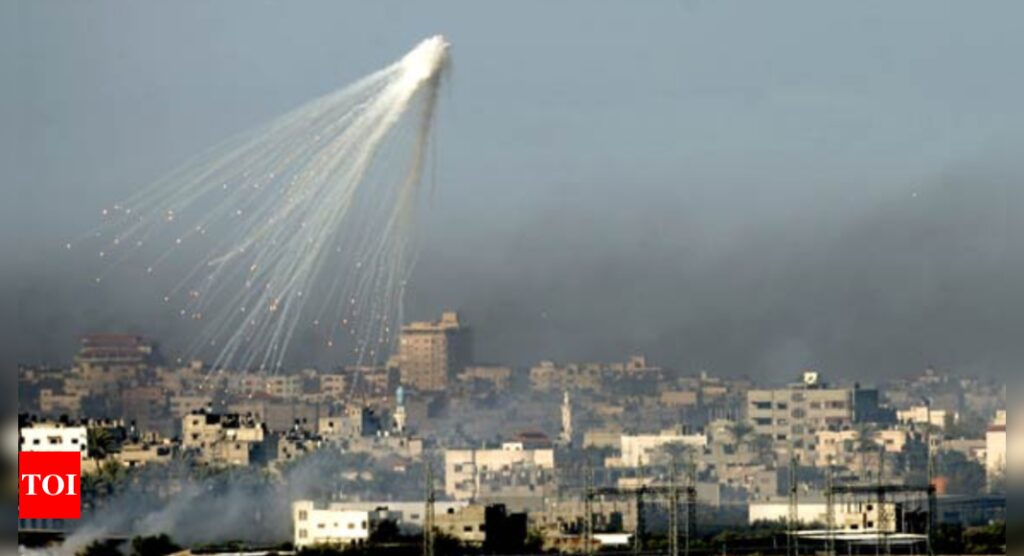[ad_1]
Israel has increased airstrikes on the Gaza Strip — one of the most crowded places on Earth — and sealed it off from water, food, fuel and other supplies in retaliation for a bloody incursion by Hamas militants that claimed at least 1,000 Israeli lives.
The airstrikes in Gaza Strip have claimed around 700 lives so far.
Several photos, videos, and claims on social media allege that Israeli forces are using white phosphorous on the civilian population of Gaza.
Not the first time
This is not the first time that Israel has been accused of using the tightly regulated weapons.
After several months of denying all reports and ignoring international pressure, Israel admitted to “using munitions containing white phosphorus” during its offensive on the Gaza Strip in December 2008-January 2009.
The Israeli military had initially categorically denied using white phosphorus entirely, saying: “The IDF acts only in accordance with what is permitted by international law and does not use white phosphorus.”
However, numerous reports from human rights groups during the war indicated that white phosphorus shells were being used by Israeli forces in populated areas.
On January 5, 2009, The Times of London reported that telltale smoke associated with white phosphorus had been seen in the vicinity of Israeli shelling. On January 12, it was reported that more than 50 patients in Nasser Hospital were being treated for phosphorus burns.[30]
On January 15, 2009, the headquarters of the United Nations Relief and Works Agency in Gaza City was struck by submunitions from Israeli artillery shells, setting fire to pallets of relief materials and igniting several large fuel storage tanks.
After the Israel Defense Forces had officially denied for months having used white phosphorus during the war, the Israeli government released a report in July 2009 that confirmed that the IDF had used white phosphorus in both exploding munitions and smoke projectiles.
The report argues that the use of these munitions was limited to unpopulated areas for marking and signaling and not as an anti-personnel weapon.
During the 2006 Lebanon War, Israel said it had used phosphorus shells “against military targets in open ground” in south Lebanon. Israel said that its use of these munitions was permitted under international conventions. However, president of Lebanon Émile Lahoud said that phosphorus shells were used against civilians.
What is white phosphorous?
White phosphorus munitions are not banned under international law, but because of their incendiary effects, their use is supposed to be tightly regulated.
In 1972, the United Nations General Assembly passed a resolution calling incendiary weapons a “category of arms viewed with horror”.
The definition in Article 1 of Protocol III of the Convention on Certain Conventional Weapons excludes multipurpose munitions, particularly those containing white phosphorus. Because white phosphorus has legal uses, shells filled with it are not directly prohibited by international humanitarian law.
Experts consider them not as incendiary, but as masking, since their main goal is to create a smoke screen.
The chemical characteristics of the substance make phosphorus bombs especially dangerous: the burning temperature of phosphorus is 800–2500°C; it sticks to various surfaces, including skin and clothes; the burning substance is difficult to extinguish.
White phosphorus can cause deep burns down to the bones, and remnants of the substance in the tissues can ignite again after the initial treatment.
It is difficult for military doctors, who are usually limited by medical resources, to provide timely and full assistance to the victims.
Even burn survivors can die from organ failure due to the toxicity of white phosphorus.
In addition, fires caused by incendiary projectiles can destroy civilian buildings and property, and damage crops and livestock.
[ad_2]
Source link











More Stories
We can’t wait to face India in the final: Pat Cummins | Cricket News
Railways plans 3,000 additional trains in next 4-5 years to minimise number of waitlisted tickets | India News
Faridabad: Man dies after ‘falling from hotel room window’ while partying with friends